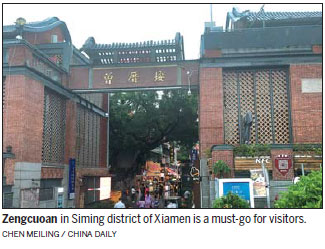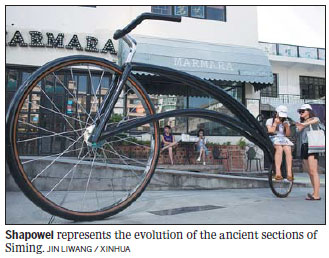

Some people say, if you know Siming district well, then you will really know the city of Xiamen in Fujian province. If visitors take the time to roam the streets and city blocks, then they will know that is true.
Its 'treasure island', Gulangyu, listed as one of the UNESCO World Cultural Heritage Sites in China, is located in Xiamen's bay. Nowadays it attracts 50,000 domestic and international visitors every day.
Known in the local dialect as Kulangsu, the beautiful island is a place featuring old colonial mansions, luxuriant foliage and curving roads, as well as boutiques, kitsch bars, modern restaurants and hotels.
Diverse influences - including Western, Southeast Asian and Fujian Hokkien cultures - fl owed to the island through the mid-19th and 20th centuries, when the island was governed by both foreign and Chinese people.
Standing on top of Sunlight Rock, visitors can spot the modern city of Xiamen over Lujiang Bay. The metropolitan buildings there contrast with the banyan trees and graceful roofs of Gulangyu Island's European mansions.
"I rarely get up at 5:30 am to catch the sunrise. But the sunrise on Sunlight Rock was worth it. I took some really great pictures," said Wang Changxiaolei, a visitor from Jiangsu province, who loves travel and photography.
If Gulangyu celebrates preserving what is left of the past of Siming district, then Shapowei - a small harbor area which is the oldest part of Xiamen - represents the evolution of the ancient sections of the city.
The local government introduced a number of innovative workshops there in the cultural industry, and at the same time retained the original look of Shapowei as a fishing harbor.
"When I first came to Shapowei, I saw a great deal of fishing boats, which looked beautiful at sunset," said Jiang Huan, an owner of a Mexican restaurant in Shapowei, who started the business two years ago.
During that time, newfangled shops and restaurants continued to settle there, making the area a new landmark in Xiamen.
A similar thing happened in the village of Xitouxia, a remote fishing spot in Siming district in the past, is now a tourist resort that attracts photographers.
Each year, the village receives at least 30,000 couples - wanting their wedding photos taken. It is estimated that more than half of them come from out of town.
On its 13-hectare land, there are 10 wedding photographic organizations and more than 70 photo workshops.
The constant stream of visitors there at the same time serves to boost the local services industry.
Besides photography, the overall services industry includes themed household hotels, cafes, restaurants as well as rent. Together they generated around 1 billion-yuan ($146.75 million) in income in 2016.
Another 'must go' for visitors to Xiamen is Zengcuoan, once a small fishing village, dating back to the Qing Dynasty (1644-1911).
But now, it has gained fame as a gathering place for cultural creativity.
More than 1,200 themed hotels, shops as well as restaurants, pack its narrow roads, which receive over 10 million visitors every year.
liyou@chinadaily.com.cn


(China Daily 09/04/2017 page11)